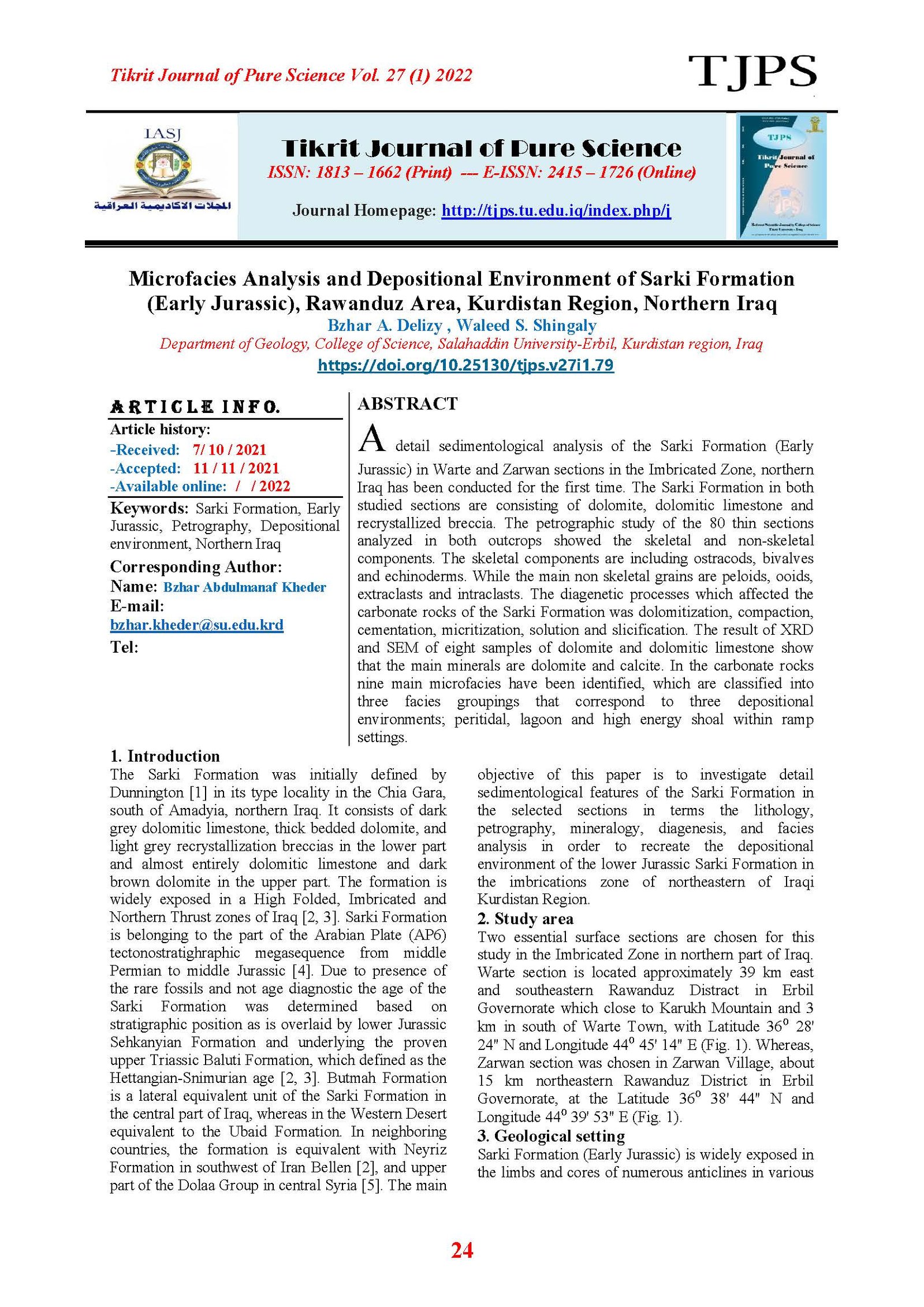Microfacies Analysis and Depositional Environment of Sarki Formation (Early Jurassic), Rawanduz Area, Kurdistan Region, Northern Iraq
Main Article Content
Abstract
A detail sedimentological analysis of the Sarki Formation (Early Jurassic) in Warte and Zarwan sections in the Imbricated Zone, northern Iraq has been conducted for the first time. The Sarki Formation in both studied sections are consisting of dolomite, dolomitic limestone and recrystallized breccia. The petrographic study of the 80 thin sections analyzed in both outcrops showed the skeletal and non-skeletal components. The skeletal components are including ostracods, bivalves and echinoderms. While the main non skeletal grains are peloids, ooids, extraclasts and intraclasts. The diagenetic processes which affected the carbonate rocks of the Sarki Formation was dolomitization, compaction, cementation, micritization, solution and slicification. The result of XRD and SEM of eight samples of dolomite and dolomitic limestone show that the main minerals are dolomite and calcite. In the carbonate rocks nine main microfacies have been identified, which are classified into three facies groupings that correspond to three depositional environments; peritidal, lagoon and high energy shoal within ramp settings.
Article Details

This work is licensed under a Creative Commons Attribution 4.0 International License.
Tikrit Journal of Pure Science is licensed under the Creative Commons Attribution 4.0 International License, which allows users to copy, create extracts, abstracts, and new works from the article, alter and revise the article, and make commercial use of the article (including reuse and/or resale of the article by commercial entities), provided the user gives appropriate credit (with a link to the formal publication through the relevant DOI), provides a link to the license, indicates if changes were made, and the licensor is not represented as endorsing the use made of the work. The authors hold the copyright for their published work on the Tikrit J. Pure Sci. website, while Tikrit J. Pure Sci. is responsible for appreciate citation of their work, which is released under CC-BY-4.0, enabling the unrestricted use, distribution, and reproduction of an article in any medium, provided that the original work is properly cited.
References
[1] Dunnington H.V. 1958. Generation, migration, accumulation and dissipation of oil northern Iraq. In: Weeks, G.L. (ed.) Habitat of oil, a symposium. American. Association of Petroleum Geologists, Tulsa.
[2] Bellen, R.C. et al. (1959). Lexique Stratigraphique International Asia, Iraq. Intern. Geol. Congr. Comm. Stratigr., 3, Fasc. 10a, 333p.
[3] Jassim, S.Z. and Buday, T. (2006) Late Permian-Liassic Megasequence AP6, chapter 9, in Jassim, S.Z., and J.C. Goff, eds., Geology of Iraq, first edition: Brno, Czech Republic, Prague and Moravian Museum, p. 104-116.
[4] Sharland, P.R. et al. (2001). Arabian Plate Sequence Stratigraphy. GeoArabia, Special publication 2, Gulf Petro Link, Bahrain, 372p.m Pet., 52(4). 1087-1100.
[5] Dubertret, B. (1966). Liban, Syria et brdure des pays voisins. Notes and Memoires Meyen Orient, Vol, VIII, Paris.
[6] Al-Saad, H. (2008). Stratigraphic distribution of the Middle Jurassic Foraminifera in the Middle East. Rev. Paléobiol. 27 (1), 1-13, Genève. Elsevier. Amsterdam, 658 p.
[7] Fouad, S.F. (2015). Tectonic map of Iraq, scale 1: 1000 000, 2012. Iraqi Bulletin of Geology and Mining, 11(1), 1-7.
[8] Dunham, R.H. (1962). Classification of carbonate rocks according to depositional texture. In: Ham, W.E., edition. Classification of carbonate rocks.
American Association of Petroleum Geologists, 1. 108-121.
[9] Sissakian, V. K. (2000). Geological map of Iraq. Sheets No.1, Scale 1:1000000, State establishment of geological survey and mining. GEOSURV, Baghdad, Iraq.
[10] Gregg, J.M. and Sibley, D.F. (1984). Epigenetic dolomitization and origin of xenotopic dolomite texture. Journal of Sedimentary and Petrography. 54 (3), 908-931.
[11] Longman, M.W. (1980). Carbonate diagenetic textures from upper nearsurface diagenetic environment. AAPG Bulletin, 64, 461-486.
[12] Tucker, M.E. (1981). Sedimentary petrology, An introduction. Oxford, Blackwell Scientific Publications.
[13] Wilson, J.L. (1975). Carbonate facies in geological history: New York, Springer, 471 p.
[14] Flugel, E. (1982). Microfacies Analysis of Limestones, Springer – Verlag, Berlin. 633 p.
[15] Flugel. E. (2004). Microfacies of Carbonate Rocks, Analysis, Interpretation and Application: Springer-Verlag, Berlin, 976 p.
[16] Al -Badry, A.M.S. (2012). Stratigraphy and geochemistry of Jurassic formations in selected sections – northern Iraq: PhD dissertation (unpublished), Science College, University of Baghdad, Baghdad, Iraq, 162 p.
[17] Edillbi, N.F. et al. (2021). Depositional environment of the upper Triassic Baluti Formation in Gara anticline, Kurdistan region, north Iraq: insight from microfacies and biomarker characteristics. Iraqi Geological Journal, 54(1E), 29-42.
[18] Barazani, A.T and Al-Qayim, B. (2019). Dolomitization and porosity evaluation of Khurmala Formation, Gara anticline, Duhok area, Kurdistan region, Iraq. Iraqi Geological Journal, 52, 2, 1-17.
[19] Machel, H.G. (2004). Concepts and models of dolomitization: a critical reappraisal. Geological Society of London , Special Publications 235, 7-63.
[20] Warren, J. (2000). Dolomite: occurrence, evolution and economically important associations. Earth-Science Reviews, 52, 1-81.
